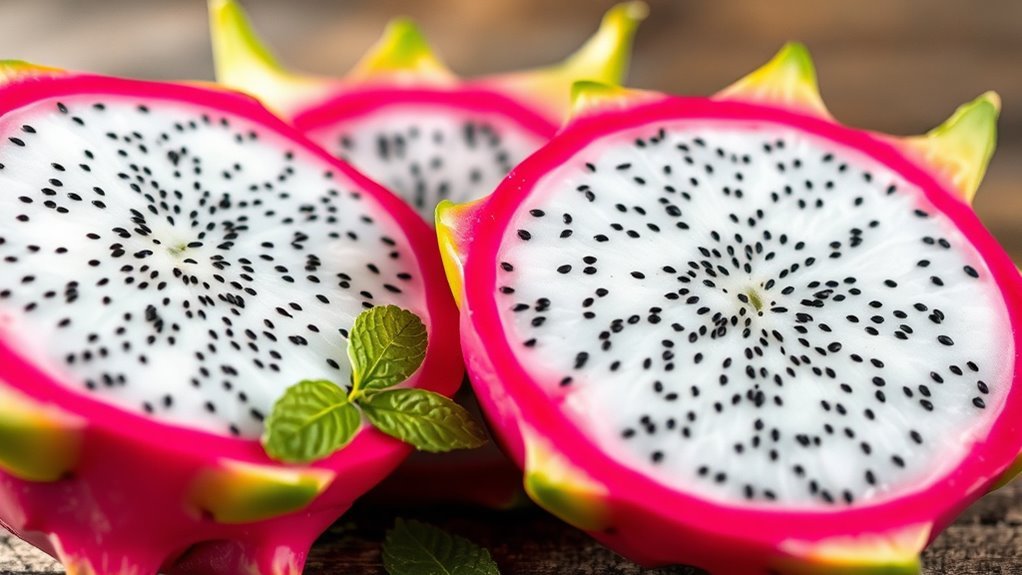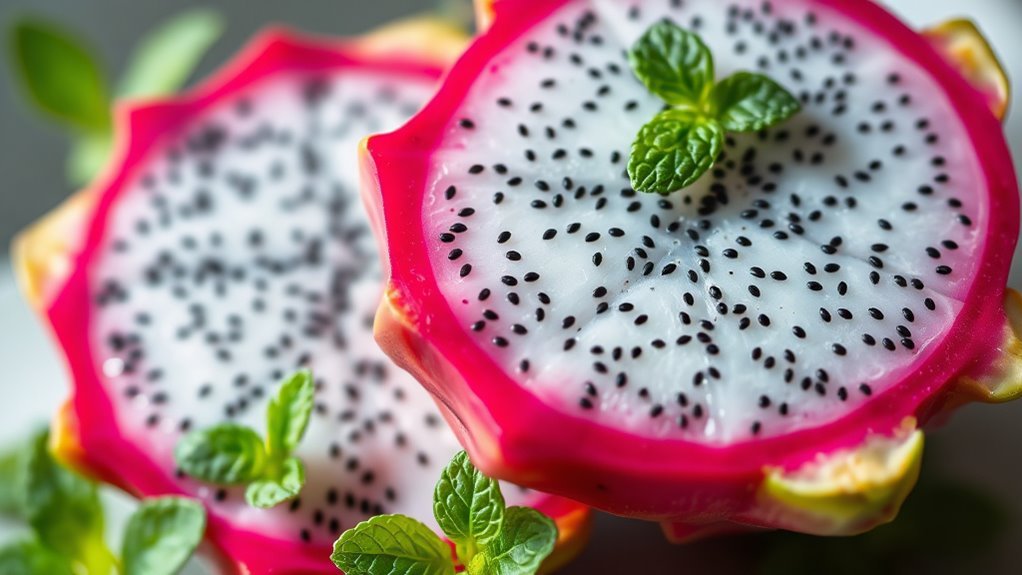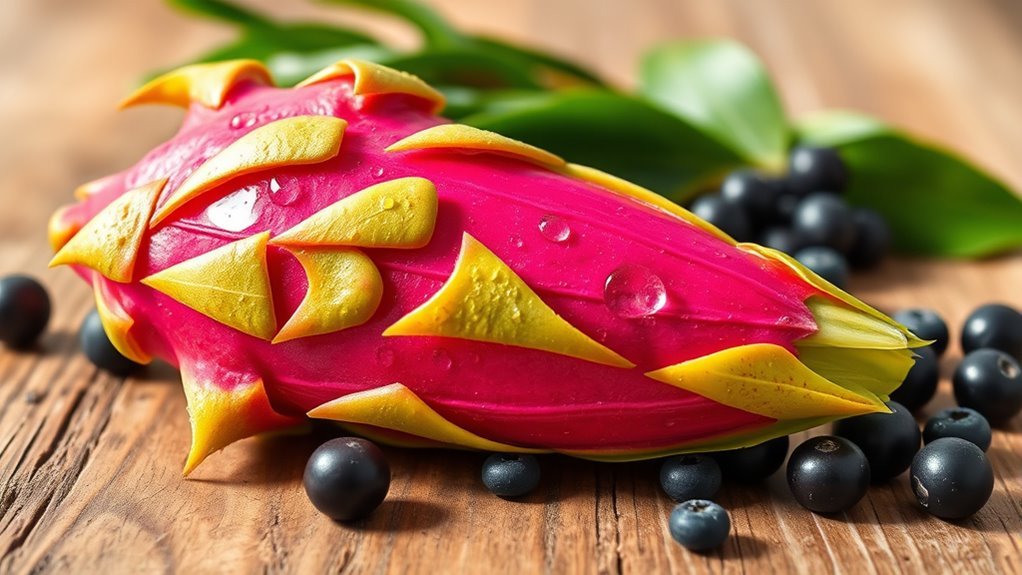Yes, dragon fruit can fit well into a keto diet due to its low carbohydrate content and high fiber levels. With only about 11-13 grams of carbs per 100 grams, it’s lower than fruits like bananas and apples. Its antioxidants and vitamin C also offer significant health benefits. Portion control is important to stay within carb limits, but dragon fruit’s unique profile makes it a smart choice for managing keto effectively. You’ll discover more benefits and tips ahead.
Nutritional Profile of Dragon Fruit

When considering the nutritional profile of dragon fruit, it’s essential to look at its macro and micronutrient content. This vibrant fruit, available in several dragon fruit varieties like Hylocereus undatus and Hylocereus costaricensis, offers a unique blend of vitamins and minerals. It’s low in calories yet high in fiber, making it an excellent choice for those seeking a nutrient-dense option. The fruit is rich in antioxidants, particularly vitamin C, which supports immune function. Its culinary uses are diverse; you can enjoy it fresh, blend it into smoothies, or incorporate it into salads. Understanding these aspects can empower you to make informed dietary choices while appreciating the freedom to explore various flavors and textures in your meals.
Carbohydrate Content Analysis

When considering dragon fruit on a keto diet, it’s essential to analyze its carbohydrate content. Typically, a 100-gram serving contains around 11 grams of carbohydrates, which can impact your daily carb limit. Understanding the appropriate serving size can help you enjoy this fruit without exceeding your keto goals.
Dragon Fruit Carbs Overview
Dragon fruit, also known as pitaya, contains approximately 13 grams of carbohydrates per 100 grams. This carb content can vary slightly among different dragon fruit varieties, such as the white-fleshed, red-fleshed, and yellow dragon fruits. If you’re looking to incorporate this exotic fruit into your diet, you might consider dragon fruit recipes that highlight its unique flavor while being mindful of your carb intake. For example, a smoothie or salad featuring dragon fruit can provide a revitalizing option without exceeding your carb limits. Understanding the carbohydrate content is essential for those following a low-carb or keto lifestyle, allowing you the freedom to enjoy this vibrant fruit within your dietary goals.
Keto-Friendly Serving Size
Although dragon fruit can be a delightful addition to your diet, determining a keto-friendly serving size is vital for managing carbohydrate intake. A typical serving size is about 100 grams, containing roughly 11-13 grams of carbohydrates. For those strict on keto, it’s essential to practice portion control, as indulging in larger servings could quickly exceed your daily carb limit. Balancing your overall meals with dragon fruit may require you to reduce carbs from other sources. Monitoring how your body reacts to this fruit will help tailor your intake. By keeping an eye on serving sizes, you can enjoy the unique taste of dragon fruit while maintaining your keto lifestyle effectively.
Comparing Dragon Fruit to Other Fruits

When comparing dragon fruit to other fruits, it’s essential to look at their nutritional profiles, particularly their carbohydrate content and glycemic index. While dragon fruit is lower in carbs than many popular fruits, understanding how it stacks up against options like berries or bananas can help you make more informed choices. This analysis can clarify its role in a keto diet and its overall impact on blood sugar levels.
Nutritional Profile Overview
The nutritional profile of dragon fruit, also known as pitaya, offers a unique comparison to more commonly consumed fruits like apples and bananas. When you evaluate the nutritional benefits, dragon fruit stands out due to its lower calorie count and higher fiber content compared to these familiar options.
| Fruit | Calories (per 100g) | Fiber (g) |
|---|---|---|
| Dragon Fruit | 60 | 3 |
| Apple | 52 | 2.4 |
| Banana | 89 | 2.6 |
This table reflects how dragon fruit not only provides essential nutrients but also promotes digestive health with its fiber. Incorporating dragon fruit into your diet can be an invigorating and healthy choice, offering unique flavors and textures.
Carb Content Comparison
Dragon fruit’s unique nutritional profile extends beyond its calorie count and fiber content to include its carbohydrate composition, which is particularly relevant for those following a keto diet. With approximately 13 grams of carbs per 100 grams, it’s relatively low compared to other fruits. For instance, bananas can have around 23 grams, while apples contain about 14 grams. If you’re seeking keto alternatives, dragon fruit offers a colorful, revitalizing option without overwhelming your carb count. However, be mindful of portion sizes to stay within your daily carb limit. When evaluating carb sources, consider how these numbers fit into your overall dietary goals. By comparing, you can make informed choices that align with your keto lifestyle.
Glycemic Index Insights
While considering fruit options for a keto diet, understanding the glycemic index (GI) is essential, as it indicates how quickly a food raises blood sugar levels. Dragon fruit has a relatively low glycemic load, making it a favorable choice compared to higher-GI fruits like bananas or grapes. This lower GI means that dragon fruit induces a milder insulin response, which is vital for maintaining stable blood sugar levels on a keto diet. In contrast, fruits with higher glycemic loads can spike insulin levels, potentially derailing your keto efforts. By choosing dragon fruit, you’re not just enjoying a unique flavor; you’re making a strategic choice to support your low-carb lifestyle while still enjoying the freedom of including fruits in your diet.
Health Benefits of Dragon Fruit
Although often overlooked, dragon fruit offers a variety of health benefits that can enhance your overall well-being. Here are three key advantages:
- Antioxidant Properties: Dragon fruit is rich in antioxidants, which help combat free radicals and reduce oxidative stress, supporting your cellular health.
- Immune Support and Skin Health: With its high vitamin C content, dragon fruit strengthens your immune system and promotes vibrant skin, giving you a natural glow.
- Digestive Health and Hydration Benefits: Its fiber content aids digestion, while its water-rich nature keeps you hydrated, essential for weight management.
Incorporating dragon fruit into your diet not only provides essential vitamins and minerals, but also promotes overall health, making it a great addition to your wellness routine.
How to Incorporate Dragon Fruit Into a Keto Diet
Incorporating dragon fruit into a keto diet can be a delightful challenge, especially considering its unique flavor and texture. You can enjoy dragon fruit in various ways, like adding it to invigorating dragon fruit smoothies or tossing it into vibrant dragon fruit salads.
Here’s a quick guide to help you decide how to use dragon fruit effectively:
| Serving Option | Carbs (g) per 100g |
|---|---|
| Dragon Fruit Smoothie | 11.3 |
| Dragon Fruit Salad | 10.0 |
| Whole Dragon Fruit | 11.0 |
| Mixed Fruit Salad | 8.5 |
| Dragon Fruit Chunks | 9.0 |
Final Thoughts on Dragon Fruit and Keto Compatibility
When evaluating dragon fruit’s compatibility with a keto diet, it’s important to take into account its carbohydrate content in relation to your daily macro goals. While dragon fruit can add a unique flavor, it’s essential to weigh its impact on your keto lifestyle. Here are a few points to keep in mind:
- Carbohydrate Count: Dragon fruit contains about 13 grams of carbs per 100 grams, which can add up quickly.
- Portion Control: If you choose to indulge, keep portions small to stay within your carb limit.
- Fruit Alternatives: Explore lower-carb fruit alternatives, like berries, to satisfy your sweet cravings without derailing your progress.
Ultimately, moderation is key when incorporating dragon fruit into your diet.


